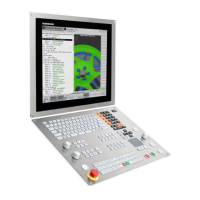32
Programming in the workshop
– Straightforward function keys for complex contours
Programming 2-D contours
Two-dimensional contours are the bread
and butter of the modern machine shop.
The TNC 640 offers a variety of possibilities
here. And—regardless of whether you are
programming a milling or turning contour—
you always use the same tools. For you
this means that you do not have to relearn,
just continue to program as usual.
Programming with path function keys
If contours are dimensioned for NC, which
means that the end points are specified in
Cartesian or polar coordinates, then you
can program them directly with the path
function keys.
Straight and circular contour elements
To program a line segment, for example,
simply press the key for linear traverse. The
TNC 640 asks for all information required
for a complete programming block, such as
target coordinates, feed rate, tool compen-
sation and machine functions. Appropriate
path function keys for circular movement,
chamfers, and corner rounding simplify
your programming. To avoid surface blem-
ishes during approach or departure from
the contour, movement has to be smooth—
that is, tangential.
You simply specify the starting or end point
of the contour and the approaching or
departing radius of the cutter edge—the
control does the rest for you.
The TNC 640 can look ahead over a radius-
compensated contour for up to 99 blocks
to watch for back cutting and avoid contour
damage such as can occur when roughing
a contour with a large tool.
Circular path defined
by its end point, with
a smooth (tangential)
departure from the
previous contour
element
Circular path defined
by its radius, end point
and rotational
direction
Circular path defined
by its center, end
point, and rotational
direction
Corner round-
ing: Circular
path defined by radius
and corner point, with
a smooth (tangen8tial)
transition to its adjoin-
ing contour elements
Straight line: Straight
line defined by its end
point
Chamfer:
Defined by the
corner point and
chamfer length

